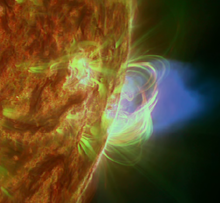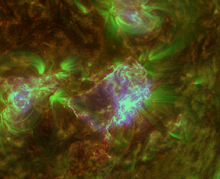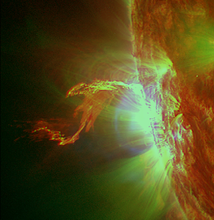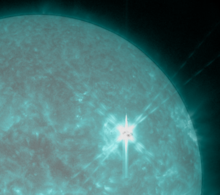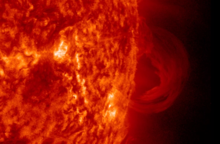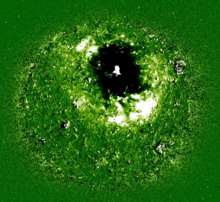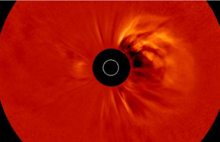news
Submitted on 2014-04-29
Last week on 25 April, an X1 flare erupted from behind the west limb peaking at 00:27UT. The source region was NOAA 2035 which had completely rounded the west limb by noon on 24 April. This group had produced multiple, but low-level C-class flares in the preceding days. The flare caused a radio black-out above the Pacific.
Submitted on 2014-04-23
A strong M7 flare occurred in NOAA 2036 on 18 April (peak at 13:03UT). This sunspot region developed on disk in just a few days (image underneath), was magnetically complex but had not produced any strong flare until that day.

Submitted on 2014-04-16
During the morning hours of Saturday 12 April, a flare took place near the Sun's southeast limb. It started at 07:15UT and reached its maximum (C5.0) at 07:27UT, then gradually decreased in intensity to end at 08:07UT. It occurred near the trailing part of NOAA 2035, which had shown some low level (C-class) flaring activity during the previous 2 days while rounding the east limb.

Submitted on 2014-04-09
Usually, strong solar flares (X-class) are associated to big and complex sunspot groups, reaching maximum areas equivalent to 15 times the surface area of the Earth. That's why it was interesting to see that two recent X-class flares were produced in regions which were much smaller. Indeed, the X-class flares on 25 February and in particular on 29 March this year took place in sunspot regions that hardly reached an area similar to that of the Earth's surface (about 170MH, see Note 1).

Submitted on 2014-04-02
Homologous flares are the solar equivalent of identical twins. They concern a series of solar flares taking place repetitively in the same active region with essentially the same position and with a common pattern of development, i.e. having the same main footpoints and general shape in the main phase as defined in H-alpha or EUV-imagery. Though not a requirement, homologous flares often have similar strength, and if there are more than two, they sometimes occur within similar time intervals.

Submitted on 2014-03-26
We are now more than 5 years in the current solar cycle (SC), and so far we have not experienced a single extreme geomagnetic storm.
Submitted on 2014-03-19
Over the last few weeks, big, complex sunspot groups and associated high flaring activity got everybody's attention. One would almost forget that solar filaments are also part of the solar activity. Time for a change!
Submitted on 2014-03-06
Everybody has noticed it: Over the last few months, solar activity has shifted into a higher gear.
Submitted on 2014-02-27
In a previous news item, it was already discussed how some CMEs use unconventional techniques to get to Earth undetected and create all of a sudden a geomagnetic disturbance.
Guess what? Those sneaky CMEs found a new way to surprise the space weather forecasters!...

Pages
Zircon - This is a contributing Drupal Theme
Design by
WeebPal.

